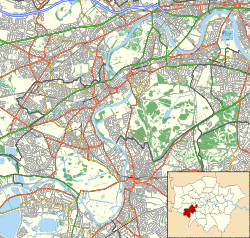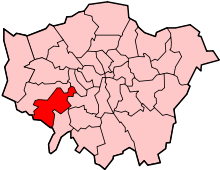Richmond Royal Hospital
Richmond Royal Hospital, on Kew Foot Road in Richmond, London, is a mental health facility operated by South West London and St George's Mental Health NHS Trust, which has its headquarters at Springfield Hospital in Tooting. The hospital's original block is Grade II listed.[2]
| Richmond Royal Hospital | |
|---|---|
| South West London and St George's Mental Health NHS Trust | |
 | |

| |
 Shown in Richmond upon Thames | |
| Geography | |
| Location | Richmond, London, England |
| Coordinates | 51°28′0.3″N 0°18′1.2″W |
| Organisation | |
| Care system | NHS England |
| Type | Specialist |
| Services | |
| Speciality | Mental health facility |
| History | |
| Opened | c. 1750[1] |
| Links | |
| Lists | Hospitals in England |
Listed Building – Grade II | |
| Official name | Original Block of Richmond Royal Hospital |
| Designated | 25 June 1983 |
| Reference no. | 1193875 |
History
The original hospital block is a mid-18th century[1] brown brick house with a Roman Ionic porch. It was the home of the poet James Thomson (1700–1748), who lived there from 1736 until his death.[2] The site is marked by a blue plaque.[3][4][5] Thomson wrote his most famous works there including the masque Alfred, which includes the poem "Rule, Britannia" (1740), "The Castle of Indolence" (1748) and "The Seasons" (1738). His poem "Rule, Britannia" was set to music by Thomas Arne in 1740 and became a patriotic song. There is a memorial to him in Richmond Park.[6]
After Thomson's death the house was bought by a friend, George Ross, who enlarged it and gave it the name Rossdale Cottage.[7] Over the years the name was altered slightly to Rosedale Cottage.[7] In 1786 it was sold to the widow of Admiral Edward Boscawen. After she died in 1805 it was bought by Charles Talbot, the 15th Earl of Shrewsbury, who changed the name to Shrewsbury House.[2]
In February 1868 it was opened as a hospital, by the Earl and Countess Russell.[8] Additions were made to the building in 1896; the architects were Smith and Brewer.[1] After Queen Victoria became the patron of the hospital, it became the Royal Hospital, Richmond in 1895.[9] Princess May's Ward for Children was opened by the Duke and Duchess of York in July 1896 and the Swan Memorial Ophthalmic Wing was opened by the Prince and Princess of Wales in April 1907.[9]
The hospital joined the National Health Service in 1948.[9] The rehabilitation unit on Evelyn Road, behind the main building, was built in 1980: the architects were Hutchison, Locke and Monk.[1]
References
- Cherry, Bridget and Pevsner, Nikolaus (1983). The Buildings of England – London 2: South. London: Penguin Books. p. 521. ISBN 0-14-0710-47-7.CS1 maint: multiple names: authors list (link)
- Historic England. "Original Block of Richmond Royal Hospital (1193875)". National Heritage List for England. Retrieved 22 September 2016.
- "Blue Plaques". Visit Richmond. London Borough of Richmond upon Thames. Retrieved 9 October 2012.
- "The View from Richmond Hill" (PDF). Local History Notes. London Borough of Richmond upon Thames. Archived from the original (PDF) on 4 February 2012. Retrieved 9 October 2012.
- Seccombe, Thomas (1898). "Thomson, James (1700–1748) (DNB00)". Dictionary of National Biography, 1885–1900, Volume 56. Retrieved 26 September 2012.
- "Monuments in Richmond Park". The Royal Parks. Archived from the original on 4 February 2013. Retrieved 8 May 2015.
- "James Thomson 1700–1748" (PDF). Local History Notes. London Borough of Richmond upon Thames. Archived from the original (PDF) on 24 September 2015. Retrieved 16 July 2013.
- Cloake, John (1991). Richmond Past. Historical Publications. p. 84. ISBN 0-948667-14-1.
- "Royal Hospital, Richmond". Lost Hospitals of London. Retrieved 29 June 2018.
